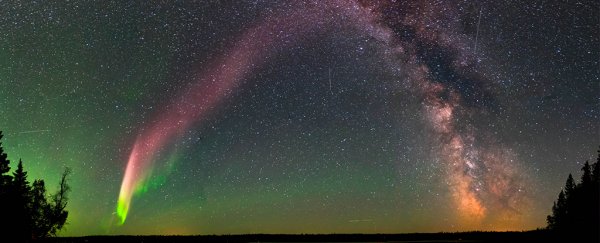Last April, amateur aurora-chasers stumbled across a strange light in the northern skies that was a little different to the usual shimmering curtains of colours. They named it Steve.
A chance alignment in space and ground imagery helped astronomers piece together exactly what causes the phenomenon, adding a bright new element to a decades old discovery. And now they're ready to reveal STEVE's super secret identity.
Technically, STEVE is an acronym that stands for Strong Thermal Emission Velocity Enhancement, because scientist just love their acronyms.
But it was initially named plain old Steve by the Facebook group Alberta Aurora Chasers, in honour of a scene in the animated movie Over the Hedge.
Either way, STEVE has been a rather mysterious phenomenon.
Unlike other aurora, this light appears as a wavering 'picket fence' of purple tinged with green, often occurring at lower latitudes than most of the northern lights. Observers have seen the light stick around for between 20 minutes to an hour before vanishing.
The discussion among enthusiasts zoomed in on something called a proton aurora, which although not typically considered to be visible were thought to explain some of Steve's odd characteristics.
Physicist Eric Donovan from the University of Calgary in Canada wasn't convinced, and tuned the ESA's Swarm magnetic field mission to study the aurora in closer detail.
Using images of Steve taken from the ground, Donovan predicted when the Swarm mission was passing through the light's neighbourhood.
"As the satellite flew straight though Steve, data from the electric field instrument showed very clear changes," Donovan said at the time.
Those changes included a 3,000° Celsius (5,400° Fahrenheit) spike in temperature, and indications that the ribbon was 25 kilometres (15.5 miles) wide and speeding west at a rapid 6 kilometres (3.7 miles) per second.
Donovan suggested last year that he had some idea of what's behind it, but refused to comment until he and his team published - which they have now done.
It turns out that STEVE is a SAID – or a sub auroral ion drift.
Previously described as polarisation jets, SAIDs have been known to astronomers for about forty years. They're short-lived, supersonic flows of charged particles that form during a certain phase of an auroral substorm.
Substorms occur when lines in our planet's magnetic field suddenly reconfigure, sending showers of high energy charged particles crashing into our atmosphere.
In the case of a SAID, the angle of those particles as they strike a particular region of the atmosphere creates the thin strip of intense electric fields that moves at high speed.
The only problem is SAIDs have never been seen with the naked eye before.
"People have studied a lot of SAIDs, but we never knew it had a visible light," says Donovan.
"Now our cameras are sensitive enough to pick it up and people's eyes and intellect were critical in noticing its importance."
In other words, STEVE has probably been there all along. Only recently have amateur sky gazers been able to share such quality snapshots with one another and critically evaluate them.
There is more to the story, though. The data on STEVE also shows it's a particular fierce kind of SAID.
From a pool of 22 datasets on known SAID events, Donovan and his team couldn't find any that moved faster than 2.9 kilometres (1.8 miles) per second, or were hotter than 5900 degrees Kelvin.
STEVE was moving twice the speed and was 100 degrees Kelvin hotter, making it an impressive kind of SAID.
The fact SAIDs can be visible tells us a lot about the chemical and physical processes that connect different latitudes of the atmosphere.
"This provides good insight on how Earth's system works as a whole," says lead author Liz MacDonald, a space scientist at NASA's Goddard Space Flight Centre.
You can listen to MacDonald explain STEVE in more detail in the clip below:
And given so many citizen scientists are turning their eyes (and cameras) to the sky these days, we can probably expect to be seeing more of STEVE in the future.
This research was published in Science Advances.
